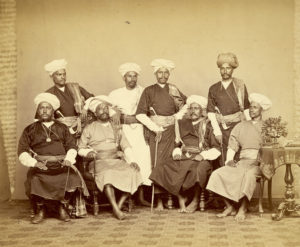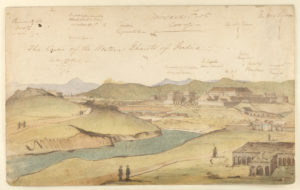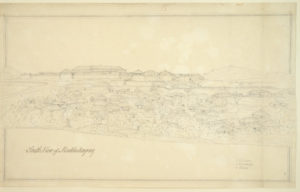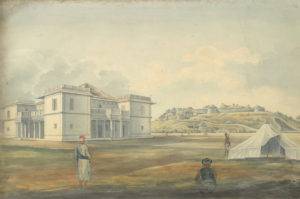
IMAGES OF COORG FROM THE PAST DATING BACK TO 19TH CENTURY
I came across four interesting images of Coorg dating back to early and mid nineteenth century.
The first is a remarkable water-colour sketch by artist John Johnson, of the guest-house in Mercara which was very likely built around 1795-1801 during Dodda Veerarajendra’s reign. There are several mentions of this guest-house in the writing of British visitors to Coorg. This accommodation was exclusively for the European visitors and had all amenities the westerners were used to. It was located at the area where the Government Central School is now situated. Mercara Fort can be seen in the background. One of the guests during Lingarajendra’s rule, General James Welsh, gave the following description of the building when he visited Coorg in 1811:
“I must now describe our own habitation, built on a small island, surrounded by paddy ground, now dry for the sole accommodation of Europeans. It is a large square, having a hall in the centre, a large covered-in verandah all round it, and four bed-rooms projecting at the angles of the verandah, all on an upper story, the lower rooms serving for the guard, attendants, store-rooms etc. It stands on a square of seventy feet, the verandah having thirty-eight glass windows, with venetian blinds outside. The bed-rooms have sixteen windows, and the hall eight glass door; every part being neatly furnished, in the English style, with beds, tables, card-tables, writing boxes, chairs, chandeliers, settees etc. etc. And there is an old butler of my Vellore friend Colonel Ridgway Mealay, and a dozen active servants, who very speedily produce an English breakfast or dinner, served up on handsome Queen’s ware, with every kind of European liquor; and what is even still more extraordinary, the cook bakes good bread!”
Another visitor, Dr. William Jeafreson, was a guest of Chikka Veerarajendra in 1830. He spent 22 days in Coorg. He wrote about the guest-house in these words:
“…There we found a splendid bungalow, fitted up for our accommodation, with every possible convenience.
Round this residence grew flowers of the richest hues and the sweetest perfume, while trees, laden with delicious fruit, among whose branches perched wild birds of the brightest and most variegated plumage, cast over us their agreeable shade.
Near this bungalow was a tank, made of black marble of the highest polish and most elaborate workmanship, in the centre of which rose a fountain, throwing up jets of water so clear and pellucid that hundreds of large and beautiful fish might be seen disporting in the basin, or else darting about in every direction after their prey. This tank was the favourite resort of the Rajah who was wont to visit it daily, at noon. Standing beside it, he would ring a small gold bell, he carried in his hand, and, at its tinkling, all the fish collected together at one spot, anxiously waiting their food (young frogs, parched peas etc.), which an attendant threw to them from a basket.
In another part of the garden was an immense black marble stand, of pyramidal form, along the five front steps of which were arranged hundreds of bleached skulls of elephants, being the Optima Spolia of the chase.”
After the British annexed Coorg in 1834, this building was surprisingly neglected. By 1860s it was in bad shape and was crumbling. It was in 1862 that 64 Coorg elders approached the British government to build a boarding house for boys attending the Central School. They suggested the site of the guest-house for the hostel, and further requested the material from the collapsed building be used for construction! The British agreed, and the boarding house was ready by 1871 under Rev. Richter’s supervision.
The following two sketches of Mercara Town are by unknown artists.
This pencil drawing of Mercara, circa 1816, is titled ‘South View of Mudhukayray’. It may be noticed that all the houses including the palace in the Fort had thatched roofs. It was the duty of farmers in the vicinity of Mercara to provide fresh straw to the palace every year soon after the harvest. The palace roof was tiled only after the British took possession in 1834.
The following sketch is dated circa 1840. It is a pen-and-ink water colour drawing, and shows many features of Coorg merged into one frame.
It may be observed that the palace in the Fort is tiled. I am not able to explain the water body surrounding the town and the building at the right-hand corner (ruins of the guest-house?).
The fourth image is a rare photograph taken in 1860 by Nicholas and Curths. It is titled – “Portrait of eight Priest from Coorg”
It is obvious that these fine gentlemen are the Thakkas. Those seated must be the Desa Thakkas, and the ones standing the Ooru Thakkas.
Editor’s Note: This is an old post. Due to technical reasons, all the images could not be carried when it was initially posted.




